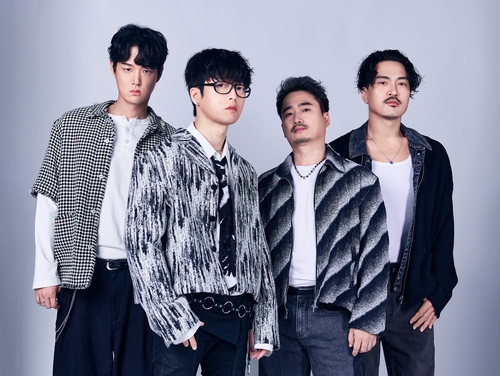It is their first full-length record in 11 years and spans 21 tracks, signaling a major musical shift.
The band blends traditional Korean music with rock and pairs the release with XR (extended reality) exhibitions and visual art projects.
Overall, the record frames both a redefinition of the band’s identity and a fresh artistic start.
Guckkasten Breaks the Silence and Unveils Gold
Since debuting in 2007, Guckkasten has been seen as an experimental force in South Korea’s rock scene.
However, by standard album timelines, the band faced an 11-year gap between full records after their 2014 second album.
During that pause, members pursued solo work and musical exploration, refining their shared sound.
In September 2025, that work crystallized as the album titled "Aurum (AURUM)".
The title is Latin for "gold," and etymologically it can also suggest a "shining dawn."
At 21 tracks, the album rejects the current single-driven streaming trend.
Instead, the band presents the whole record as a single, organic work.
In this way, they aim to expand both musical storytelling and the artistic scope of a rock album.

The set includes two lead singles, "ROLLER" and "KICK OUT."
"ROLLER" also appears in a remix that incorporates traditional Korean music (gugak), letting old and new textures clash and reconcile.
In addition, the band teamed with sculptor Ji Yong-ho (a contemporary Korean artist) to create installations inspired by the album’s 21 pieces and launched an XR exhibition to present the music as an immersive visual experience.
These moves push the release beyond a record into a broader cultural project.
The Announcement Moment
The opening statement was decisive.
“We gather our sound again and open a new chapter.”
On the release day, the label confirmed the album’s arrival and formally ended the long silence.
Fans reacted immediately: social feeds and online communities mixed anticipation with nostalgia.
Meanwhile, questions arose about the bold choice of 21 tracks.
Those questions focus on two points: the album’s artistic achievement and its appeal to a wider audience.
How Guckkasten Has Changed
The band’s musical horizon has widened.
It introduces traditional Korean musical elements, explores electronic sound design, and builds prolonged narrative tracks to reshape the listening experience.
Members say they folded the soundscapes they developed separately over the past decade into this record.
That process went beyond simple genre-mixing and involved collaboration across artistic disciplines.
As a result, sharp rock riffs coexist with more meditative, story-driven pieces.
Thus, Aurum serves as a bridge between Guckkasten’s past and their possible future.
Album Structure and Narrative
The storytelling is broad in scope.
Viewing each of the 21 tracks as a small chapter, the band ties the songs together into one long narrative.
This approach runs counter to certain modern listening habits but pursues the completeness of the record as art.
The album’s structure asks listeners for an active commitment: to hear it from start to finish.
That expectation is a modern rework of how LP-era audiences used to experience albums.
Musically, the mix of traditional instrument samples and electronic textures creates rich connective threads between songs.
Rock riffs collide with gugak melodies at times, producing an unfamiliar but invigorating sound.
With the XR exhibition added, listening becomes a multi-sensory encounter rather than a passive stream.
The Pro-Argument
The musical evolution is clear.
“This album proves Guckkasten’s maturity and willingness to take risks.”
Supporters point first to the record’s experimental depth.
They argue the 11-year gap was not merely absence but a period of reflection and reconfiguration.
The outcome appears as layered soundscapes and more mature songwriting.
In particular, integrating traditional Korean elements and remixes reads as an attempt to root contemporary rock in a local cultural identity.
Second, the album’s length and artistic expansion signal a desire to turn music into an experience rather than a disposable item.
Releasing 21 tracks in an era dominated by singles can be read as a statement protecting the album’s value as a finished work.
Viewed this way, Aurum functions as an artistic archive rather than only a commercial product.
Third, the cross-arts projects increase the record’s cultural reach.
Working with a sculptor and staging XR shows can attract audiences who might not come for rock concerts alone.
Practically, this can open revenue channels—touring, merchandise, exhibitions—that support the band’s sustainability.
In this sense, the project connects to broader questions about funding, creative entrepreneurship, and how musicians build multi-pronged careers.
Concerns from Critics
There are worries about mainstream appeal.
If commercial viability and artistry fall out of balance, long-term success becomes harder to secure.
Critics say the sheer number of tracks may dilute focus.
In streaming-driven listening, people often pick singles; many tracks risk being overlooked.
This could expose unevenness between songs and invite reassessment of the album’s overall quality.
Second, experimental elements can widen the gap with mainstream listeners.
Mixing gugak and electronic sounds enriches depth but can raise the entry barrier for listeners seeking straightforward hooks.
Some longtime fans expecting the band’s earlier sharp energy might feel alienated if the new tone departs too far from the familiar.
Third, ambitious art projects carry real financial demands.
XR shows, sculptures, and large promotions require upfront investment.
If returns are uncertain, those costs can become a burden.
So, sustaining artistic expansion requires concrete business planning—budgeting, investment, and revenue strategies.
Public and Critical Reaction
Responses are mixed so far.
Early internet reviews skew positive.
Critics praise the album’s ambition and polish while noting that some tracks’ lengths and the album’s pacing may clash with modern consumption habits.
Fans express gratitude and nostalgia alongside surprise at the record’s unfamiliar turns.
The mixed reactions show the album is not only liked or disliked but also provoking conversation.
The release also raises industry-wide questions.
In a time when music is increasingly treated as content, what is the place of the album format?
The debate forces a choice: prioritize artistic value or target commercial success.
Economic Perspective
Costs and returns need careful balancing.
Creative projects tied to album releases require budgeted funds.
Recording, installation, and XR development are all initial expenses, and recouping them typically depends on concerts, merchandise, licensing, and partnerships.
Seen this way, Aurum is both a cultural product and a potential investment.
Therefore, the band and their team must present a clear plan for recovering costs and a long-term business model.
From a household-budget (a simple term for personal money planning) view, fans’ spending patterns matter.
Ticket sales, physical albums, and exhibition admissions determine how much revenue these projects can generate.
Ultimately, artistic ambition intersects with the realities of cash flow and financial planning.
Long-Term Outlook
Their sustainability is being tested.
If the album wins steady support from critics and devoted fans, Guckkasten could rebuild wider influence.
The XR shows and sculptural work may draw new audiences and extend the band’s brand.
On the other hand, if early momentum fades and investments take too long to return, future projects may need to shrink or pivot.
Thus, Aurum should be read as a careful negotiation between artistic goals and business realities.
Summary and Suggestions
Balance is the key.
Aurum pursues both artistic completeness and adventurous experimentation.
To make that dual aim sustainable, the band should strengthen communication with fans, diversify revenue streams, and set clear financial plans.
Practical steps might include packaging concerts with exhibitions, offering limited-edition releases that encourage saving (a simple way for fans to plan purchases), and a subscription-style fan club to create steady income.
These measures can help protect the work’s artistic integrity while ensuring ongoing operations.
Conclusion: Aurum Is a New Starting Line
Guckkasten’s third studio album, Aurum, is more than a comeback.
The record marks both a redefinition of the band’s identity and an artistic expansion.
Of course, the 21-track scope and experimental edge may clash with mass-market tastes.
However, read as a deliberate move toward artistic completeness, this project may open a new chapter for Korean rock.
The main takeaways are these.
First, the 11-year interval is audible in the record’s reflective and reworked sound.
Second, the 21 tracks and cross-arts projects convert the album into a multidisciplinary work.
Third, a clear revenue model and financial plan must accompany artistic aims.
Now the question goes to the reader.
How will you listen to this record?
